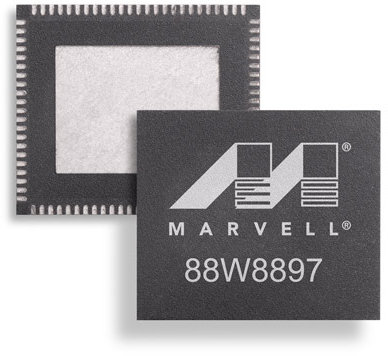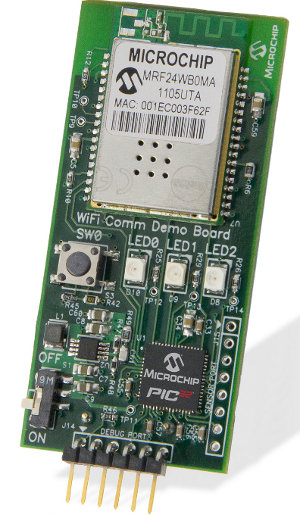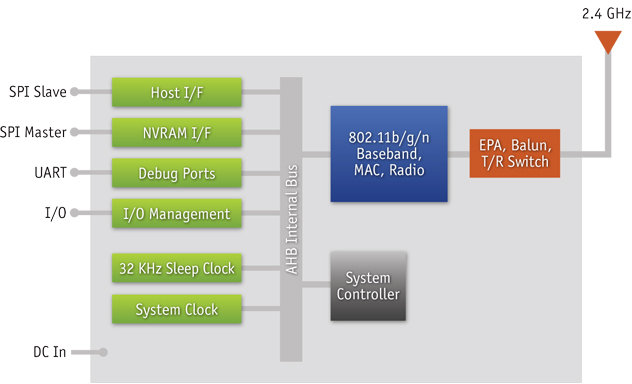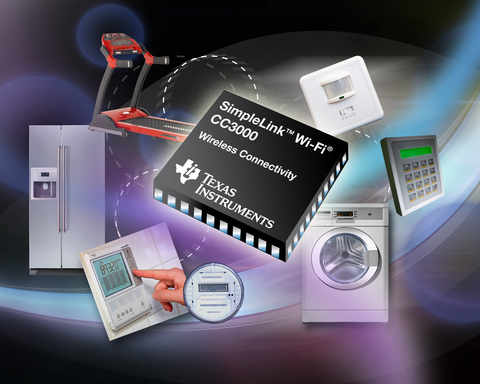Marvell has announced the Avastar 88W8897, a low-power radio chip supporting 802.11ac, near field communication (NFC) and Bluetooth 4.0, aimed at mobile and HD multimedia devices such as ultrabooks, tablets, gaming consoles and smart TVs. Marvell claims the 88W8897 SoC enables a rest of bill of materials (RBOM) footprint reduction of 40-to-50 percent and cost reduction of 75 percent compared to previous wireless solutions. Key features of Marvell Avastar 88W8897 chip include: Wi-Fi 802.11ac – This standard increases bandwidth available over the Wi-Fi link (theoretically up to 1 Gb/s) with throughput up to 867 Mbps for the 88W8897. This kind of throughput allows reliable high-definition (HD) video streaming, tunneled direct link setup (TDLS) and high-speed wireless backup and sync for mobile devices. NFC – NFC allows consumers to pay for items with the tap of a phone via mobile commerce and point-of-sale (e-wallet) applications. It can also enable one-tap pairing […]
25 USD Hacker Friendly Electric Imp “WiFi-ises” Your Coffee Machine
Electric Imp is a device in an SD card form factor that aims at providing Wi-Fi connectivity to household appliances at low cost and bringing the Internet of Things (IoT) closer to reality. The Imp will also connect to a Cloud service handled by the company (which is also called Electric Imp). The device Wi-Fi connection can easily be configured using an iOS or Android smartphone thanks to BlinkUp, a patent-pending scheme supporting WEP, WPA and WPA2 encryption schemes as well as WPS setup. Electric Imp developers expect this device to save resources (e.g. electricity) by taking into account environmental conditions (e.g. occupancy, temperature..), improve security & safety and overall provide better monitoring and control of devices. For example, this could enable support services to remotely diagnose a device, and provide timely customer support. Here are the Electric Imp hardware specifications: ST Micro STM32 Cortex M3 MCU 802.11b/g/n WiFi 6 […]
IEEE Updates 802.11 Standard to Support 600Mb/s Wi-Fi and Approves 802.1aq Standard for Large Ethernet Networks
IEEE has recently announced a standard update for WiFi (802.11-2012) which adds support for 3.7 GHz bands, 600Mb/s throughput and mesh networking among other things, and approved 802.1aq Shortest Path Bridging standard, which will streamline the creation and management of large Local and Metropolitan Area networks by using the next-generation VLANs. IEEE Wi-Fi 802.11-2012 Standard IEEE 802.11-2012 is the 4th revision of the Wi-Fi standard. It has been expanded by supporting faster and more secure devices, while offering improved Quality of Service and cellular network hand-off. Key amendments to the standard: IEEE 802.11n now defines MAC and PHY modifications to enable throughput up to a maximum of 600Mb/s Direct-link setup “Fast roam” Radio resource measurement Operation in the 3650-3700MHz band Vehicular environments, mesh networking, security, broadcast/multicast and unicast data delivery Interworking with external networks and network management. IEEE 802.11 is available for purchase for $5 at the IEEE Standards Store. […]
Shenzhen Tena Electronic Wi-Fi Display Mirroring Smart Box
Shenzhen Tena Electronics showcased an interesting “Smart Box” that can mirror a device display (smartphone, tablet, laptop..) on a TV via Wi-Fi at the Shenzhen Electronic Fair, on 10-11 April, 2012. In the video below shot by Charbax, an HTC smartphone, running a specific Android application (apparently not available on Google Play), plays back a 720p movie which is displayed on a television via sztena’s Smart Box. It’s rather choppy, but there may be quite a lot of noise with all the WiFi signals at the exhibition. I very much like this concept, but the current retail price (999 RMB – about 160 USD) makes it unattractive to me for tasks such as video playback or checking email. However, provided it’s smooth enough, games using accelerometer and gyrometer might be fun to play. Imagine a car racing game, where your mobile phone or tablet is your steering wheel and gear […]
Microchip Unveils Wi-Fi Comm Demo Board with 32-bit PIC32 MCU
After TI and Qualcomm, here’s another WiFi solution for MCU aimed at the internet of things (IoT). Yesterday, Microchip Technology announced the Wi-Fi Comm Demo Board, which combines a Microchip 32-bit PIC32 microcontroller (PIC32MX695F512H) with a low-power MRF24WB0MA embedded Wi-Fi radio transceiver module. This small (and cheap) demo board can be used to integrate with existing embedded designs and/or to evaluate Wi-Fi connectivity with a 32-bit MCU. Contrary to TI and Qualcomm, the IP network stack is not implemented in hardware, but Microchip provides a TCP/IP stack that can be freely downloaded at http://www.microchip.com/get/A3VP. This TCP/IP stack includes HTML, DHCP, DNS, IPv4/v6, SSL, etc… (See diagram below) The memory footprint is 28-34 KB depending on the modules used. I could not find details about power consumption, but the company claims their solution can also run with just 2 AAA batteries. Microchip explains that this solution can enable the rapid growth […]
Qualcomm Atheros AR4100P Provides WiFi Connectivity to the Internet of Things
In January, Texas Instruments was the first company (to my knowledge) to release a WiFi chip for the internet of things, the SimpleLink Wi-Fi CC3000, where WiFi is mostly implemented in hardware to lower power consumption. Now, the company has some competition with the announcement of Qualcomm Atheros AR4100P, an improved version of its AP4100 WiFi chipset, including IPv4/IPv6 support. The AR4100 targets the home, enterprise, smart grid and home automation and control applications that have lower data rates and transmit or receive data on an infrequent basis. The AR4100 system-in-package (SIP) features the following: Low energy Power saving modes as low as 5 µA Wake-up times as low as 2.2 ms Support for Quad SPI flash for faster wake times Low system resource requirements Low footprint host driver (25K Flash and 8K RAM) Simple, low-cost wireless system integration LGA package simplifies 2- or 4-layer PCB design Near zero RBOM […]
Linaro 12.02 Release with Kernel 3.3-rc
Linaro has just released version 12.02 based on Linux Kernel 3.3-rc and Android 4.0.3. Among the key points, they have started to work on Freescale i.MX6 SabreLite board, included libav 0.8 to Ubuntu images which provides up to 160% performance improvement while playing real-media videos and XBMC is available via PPA. Here are the highlights of the release: Android Linaro Android can now be built with current GCC 4.7 snapshots. A 4.7 based toolchain build preview is also available. Linaro Android can boot on iMX6 Sabrelite boards. All test result spreadsheets have been streamlined and are now easier to use. Bluetooth enablement have been completed for the Origen board. A Prototype of using camera on Snowball was made. Presentations Given by Linaro Android Team this cycle “Binary Blobs Attack!!!” – Embedded Linux Conference. “What Android and Embedded Linux can learn from each other” – Embedded Linux Conference. “Integrating Projects Using […]
TI SimpleLink Wi-Fi CC3000 Brings WiFi Connectivity to All Devices
Yesterday, Texas Instruments unveiled the SimpleLink product family, a portfolio of wireless connectivity technologies for low-power, low-cost embedded applications, which includes self-contained wireless processors supporting Wi-Fi, ZigBee, 6LoWPAN, and ANT. The most noticeable product is the SimpleLink Wi-Fi CC3000, a self-contained 802.11 (WiFi) network processor, that can be added to any embedded application and provide WiFi connectivity to the Internet of Things. With this solution, you can add WiFi to any device, even those powered by MCUs without operating systems such as dishwashers, toasters, refrigerators, thermostats, and factory automation equipment. I wish they’ll make new version of the MSP430 Chronos Wireless Watch with WiFi connectivity, this would remove the need for the RF Dongle. This solution features TCP, UDP and IP software stacks in the chip, it consumes 0.5% of the resources as compared to traditional Wi-Fi and only requires 6KB Flash and 3KB RAM. The company claims it can be […]







